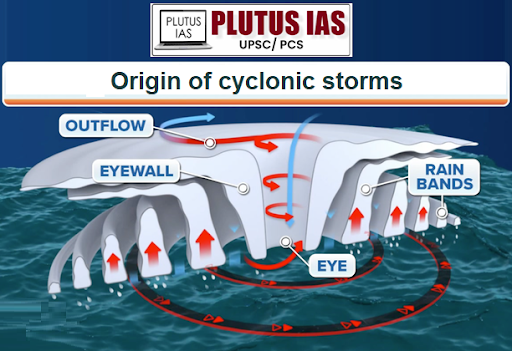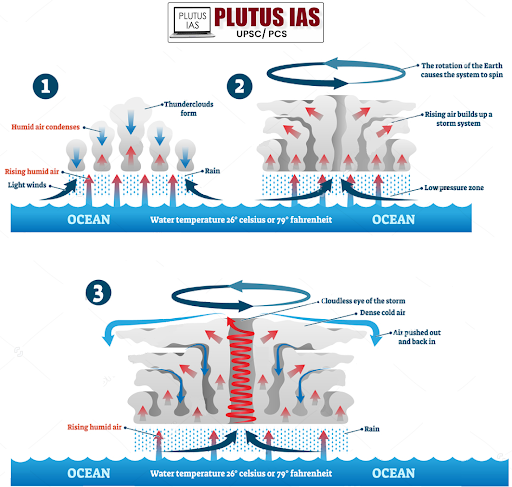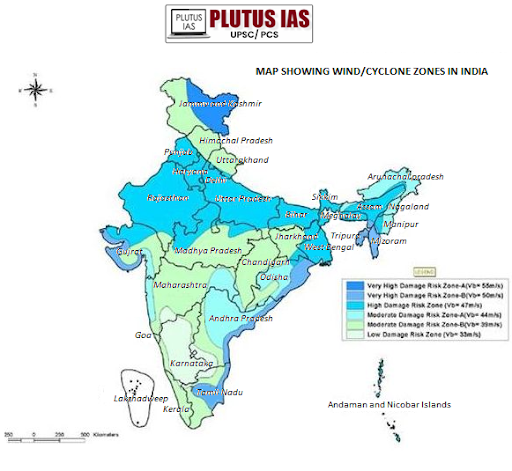31 Aug Understanding Tropical Cyclone Asna: Mechanism, Impact, and NDMA Guidelines for Preparedness
This article covers “Daily Current Affairs” and topic details of Understanding Cyclone Asna:Mechanism, Impact, and NDMA Guidelines for Preparedness.
Syllabus mapping:
GS-1: Geography: Important geomorphological phenomena.
GS-3: Disaster Management: Cyclone, its mechanism, formation conditions, consequences, NDMA guidelines, and preparedness.
For Prelims:
What is a tropical cyclone? What are the formation mechanisms and conditions for cyclone formations?
For Mains:
How tropical cyclones are named in the Indian subcontinent? What are the consequences of the cyclone as a disaster, the NDMA guidelines, and preparedness in the long term to reduce the impact of cyclones?
Why in the News?
The IMD has forecasted ‘very heavy’ rainfall in Gujarat for tomorrow and has issued a red alert for coastal Karnataka due to Cyclone Asna. This cyclone, an unusual occurrence for August over the Arabian Sea, is expected to bring significant rain to both Gujarat and coastal Karnataka.
What is a Cyclone?
Cyclones are a recurring natural hazard in India, often resulting in significant loss of life and property. Globally, the term Tropical Cyclone (TC) or simply ‘Cyclone’ is used to describe tropical weather systems where winds reach or surpass 34 knots (62 km/h). These systems are characterized by intense low-pressure areas and are among the most severe weather events in tropical regions.
World Meteorological Organization(WMO): key facts and figures about the tropical cyclones:Rank: Tropical cyclones are the second-most dangerous natural hazard, after earthquakes. Disasters: Over the past 50 years, tropical cyclones have been responsible for 1,945 disasters. Casualties: More than 779,324 people have lost their lives due to tropical cyclones in the last 50 years. Economic Losses: Tropical cyclones have caused approximately USD 1.4 trillion in economic losses since 1970. Daily Impact: On average, tropical cyclones and related hazards have caused 43 deaths and USD 78 million in damages every day over the past 50 years. Diameter: The typical diameter of a tropical cyclone ranges from 200 to 500 km but can extend up to 1,000 km. Population Growth: The population in tropical cyclone-prone regions has increased by 200% over the past 50 years. |
Classification:
Cyclones are categorized into two main types
1. Extra-Tropical Cyclones: Also known as temperate cyclones, these occur in temperate zones and high-latitude regions. They can even originate in Polar Regions. These cyclones are associated with frontal systems and are driven by temperature contrasts between air masses.
2. Tropical Cyclones: These cyclones develop over tropical or subtropical waters between the Tropics of Capricorn and Cancer. They form from organized surface wind circulation and are powered by heat from the sea. According to the World Meteorological Organization (WMO, 1976), a tropical cyclone is characterized by winds exceeding gale force (minimum of 34 knots or 63 km/h).
Distinct features of Tropical cyclone:
1. Eye: The calm, clear centre of a tropical cyclone, where winds are relatively light and skies are mostly clear. This is a low-pressure area with ascending air.
2. Eye Wall: The ring of towering thunderstorms surrounding the eye. It contains the cyclone’s most intense winds and heaviest rainfall.
3. Spiral Bands: These are bands of clouds and thunderstorms that spiral outwards from the eye. They can extend over large areas and produce heavy rain and strong winds.
4. Cyclone’s Rotation: Tropical cyclones rotate in a cyclonic manner due to the Earth’s rotation, with a counterclockwise rotation in the Northern Hemisphere and a clockwise rotation in the Southern Hemisphere.
5. Low-Pressure Centre: The core of a tropical cyclone is a region of very low atmospheric pressure, which contributes to the strong winds and the system’s overall intensity.
6. Strong Winds: Tropical cyclones are characterized by sustained winds that exceed 34 knots (62 km/h). The most intense winds are located in the eye wall.
7. Heavy Rainfall: Cyclones can produce extremely heavy rainfall, leading to flooding in affected areas.
8. Storm Surge: A rise in sea level caused by strong winds and low pressure, leading to coastal flooding and erosion.
Essential Conditions for Tropical Cyclone Formation:
1. Warm Sea Surface Temperature: Sea surface temperatures (SST) must be at least 26.5°C (about 80°F) to provide the necessary heat and moisture. These warm waters increase the evaporation rate, which provides the moisture needed for cloud formation and intensification of the cyclone.
2. Low Vertical Wind Shear: Minimal difference in wind speed and direction between different levels of the atmosphere. This Low wind shear allows the cyclone to maintain its structure and prevents the storm from being torn apart.
3. High Humidity: High humidity in the lower to mid-levels of the atmosphere. High moisture content supports the development of deep convection and cloud formation, contributing to the cyclone’s strength.
4. Presence of a Pre-existing Weather Disturbance: An initial low-pressure area or disturbance in the atmosphere. This pre-existing disturbance acts as a trigger for cyclone formation by creating a region of low pressure around which the system can develop.
5. Coriolis Force: Sufficient Coriolis force to induce rotation. The Coriolis effect, caused by the Earth’s rotation, is necessary for the cyclone’s rotation and to organize the system into a cyclonic structure.
Formation and Development of Tropical Cyclones
The development of tropical cyclones occurs in three main stages:

1. Formation and Initial Development
Warm Sea Surface: Tropical cyclones begin over warm ocean waters, typically with temperatures above 26°C (79°F) to a depth of about 60 meters. This warmth causes significant evaporation and transfer of water vapor into the atmosphere.
Atmospheric Instability: The warm, moist air rises from the ocean surface, creating atmospheric instability. This leads to the formation of towering cumulus clouds through convection. As the air rises, it cools and condenses, forming large cloud formations and thunderstorms.
2. Mature Tropical Cyclones
Intensification: As the cyclone matures, vigorous thunderstorms develop. The rising air spreads out horizontally at the tropopause level, creating a high-pressure area above the storm. This causes downward motion and warming of the air, creating a warm “eye” in the center of the cyclone.
Eye Formation: The eye of a mature tropical cyclone can take several shapes, including circular, concentric, or elliptical. The key feature of a mature cyclone is its concentric pattern of highly turbulent, giant cumulus thundercloud bands that encircle the eye.
3. Modification and Decay
Weakening: A cyclone starts to weaken when it loses its source of warm, moist air, which typically happens after landfall or when it moves over cooler waters. As the central low pressure and internal warmth decrease, the cyclone’s winds and overall intensity diminish.
Continued Threat: Even as a cyclone weakens, it can still pose significant risks to life and property due to continued heavy rainfall, storm surges, and strong winds.
INDIA AND TROPICAL CYCLONE:
The Indian subcontinent is highly vulnerable to tropical cyclones due to its extensive coastline and climatic conditions.
Geographical Exposure: India, with its 8,041-kilometer coastline, is exposed to about 10% of the world’s tropical cyclones. The majority of these cyclones form in the Bay of Bengal and affect the East Coast of India.
Frequency and Distribution: On average, five to six tropical cyclones develop each year, with two or three reaching severe intensity. Cyclones are more common in the Bay of Bengal compared to the Arabian Sea, with a ratio of approximately 4:1. Historically, from 1891 to 1990, the East coast of India experienced 262 cyclones (92 of which were severe) in a 50-kilometer-wide strip. In contrast, the West Coast saw 33 cyclones, with 19 being severe.
Seasonality: Cyclones in India typically occur during two main periods: May-June and October-November. Severe cyclones in the North Indian Ocean exhibit a bi-modal pattern, with a primary peak in November and a secondary peak in May.
Consequences of Tropical cyclones:
1. Heavy Rainfall and Flooding: Cyclone Fani, which struck the Indian state of Odisha in May 2019, exemplifies the impact of heavy rainfall and flooding. The cyclone brought intense rainfall, leading to severe flooding in several districts. Rivers overflowed, inundating large areas, and damaging homes, infrastructure, and crops. The floodwaters disrupted normal life and created a significant humanitarian crisis in the affected regions.
2. Strong Winds: Cyclone Amphan, which hit India and Bangladesh in May 2020, caused widespread destruction due to its strong winds. With wind speeds reaching up to 155 km/h (96 mph), the cyclone uprooted trees, damaged buildings, and disrupted power and communication lines. The intense winds were devastating in West Bengal and the Sundarbans region, leading to extensive damage and disruption.
3. Storm Surge: Cyclone Michaung in 2023, recently highlighted the vulnerability of Tamil Nadu and Andhra Pradesh to tropical cyclones, with significant implications for these coastal regions. A report by Climate Trends reveals that about 2.9 million people in Andhra Pradesh are highly vulnerable to such storms, intensified by the fact that 3.3 million people reside within 5 kilometers of the coastline. This proximity to the coast substantially raises the risk of exposure to cyclones and their devastating effects, including storm surges, flooding, and strong winds.
4. Landslides: Cyclone Yash, which struck eastern India in May 2021, triggered heavy rainfall that caused landslides in the hilly areas of West Bengal and parts of Jharkhand. The landslides resulted in road blockages, damage to infrastructure, and increased challenges for rescue and recovery operations. The heavy rains and unstable terrain exacerbated the impact on these regions.
5. Economic and Social Impact: Cyclone Ockhi, which affected Tamil Nadu and Kerala in December 2017, had significant economic and social repercussions. The cyclone caused extensive damage to homes, infrastructure, and agricultural lands. The displacement of communities and the destruction of property led to a severe humanitarian crisis, with prolonged recovery efforts needed to rebuild affected areas and restore normalcy.
6. Environmental Impact: Cyclone Vardah, which struck Chennai and Tamil Nadu in December 2016, had notable ecological impacts. The cyclone caused significant damage to coastal and urban green spaces, including destroying trees and vegetation. The flooding and storm surge associated with the cyclone also led to pollution of water sources, affecting local ecosystems and wildlife.
NDMA guidelines for cyclones:
The National Disaster Management Authority (NDMA) of India provides comprehensive guidelines for managing disasters, including cyclones. These guidelines are designed to mitigate the impact of cyclones and enhance preparedness, response, and recovery efforts.
1. Cyclone Preparedness and Mitigation
a. Early Warning Systems: Establish and maintain robust early warning systems to provide timely and accurate information about cyclone formation and movement.
b. Public Awareness and Education: Conduct public awareness campaigns and educational programs to inform communities about cyclone risks and safety measures.
c. Infrastructure Resilience: Improve the resilience of infrastructure to withstand cyclone impacts, including strengthening buildings, roads, and coastal defenses.
d. Community-Based Preparedness: Develop and implement community-based preparedness plans, including evacuation plans and shelter arrangements.
2. Cyclone Response and Management
a. Emergency Operations Centers (EOCs): Activate EOCs at the state and district levels to coordinate response efforts during a cyclone.
b. Evacuation and Shelter Management: Implement evacuation plans to safely move people from vulnerable areas to designated shelters.
c. Search and Rescue Operations: Conduct search and rescue operations to assist affected individuals and communities.
d. Relief and Rehabilitation: Provide immediate relief supplies, including food, water, medical aid, and other essentials to affected populations.
3. Post-Cyclone Recovery and Reconstruction
a. Damage Assessment: Conduct thorough damage assessments to evaluate the impact of the cyclone on infrastructure, properties, and livelihoods.
b. Reconstruction and Rehabilitation: Develop and implement reconstruction plans to rebuild affected areas, focusing on resilience and sustainable development.
c. Financial Support and Insurance: Facilitate financial support and insurance mechanisms for individuals and businesses affected by the cyclone.
d. Review and Improvement: Review and analyze the response and recovery efforts to identify lessons learned and areas for improvement.
4. Coordination and Collaboration
a. Multi-Agency Coordination: Ensure coordination among various government agencies, NGOs, and community organizations involved in disaster management.
b. International Cooperation: Engage in international cooperation and exchange of best practices for cyclone management.
Strategic Measures for Enhancing Cyclone Preparedness and Mitigation
To enhance cyclone preparedness and mitigate their impact, several strategic measures have been proposed by various committees and organizations in India:
Upgrading Forecasting Capabilities and Infrastructure: Establishing advanced weather radars and satellite systems to improve cyclone prediction accuracy is crucial. This recommendation was emphasized by the Goswami Committee (2004), which also advocated for enhancing early warning systems to ensure timely alerts. The National Disaster Management Plan (NDMP) (2009) and the National Disaster Management Authority (NDMA) Guidelines further stressed the need for improved forecasting and communication systems to effectively reach vulnerable populations.
Coastal Zone Management and Protection: Constructing seawalls, embankments, and reforesting mangroves are vital coastal protection measures. The High-Level Committee on Disaster Management in 2016 also called for the development of an integrated coastal zone management plan to address cyclone risks and coastal erosion.
Building Resilient Infrastructure: Promoting cyclone-resistant buildings and critical facilities is essential to reduce damage during cyclones. Recent recommendations from Cyclone Risk Mitigation Measures of 2021 also emphasized the construction of robust coastal defenses and the implementation of cyclone-resilient building codes.
Community-Based Preparedness and Engagement: Developing localized disaster response plans and involving communities in preparedness efforts are critical. The NDMP of 2009 has highlighted the importance of public awareness campaigns and capacity building for effective local response.
Enhanced Training and Capacity Building: Regular training programs and simulation exercises for disaster management professionals and community members are necessary to improve readiness. This need was identified by the NDMA Guidelines and the National Disaster Management Plan (NDMP) (2009), which called for significant capacity building and resource allocation to state and district authorities.
Coordination and Research: Strengthening coordination mechanisms among government agencies, NGOs, and international bodies is crucial for effective cyclone management. The a need for enhanced research and development to improve cyclone prediction models, as highlighted by the High-Level Committee on Disaster Management.
Economic Protection and Insurance: Implementing insurance and financial protection schemes to mitigate economic losses from cyclones is recommended. The Cyclone Risk Mitigation Measures (2021) advocated for financial protection to reduce the economic impact on individuals and businesses.
International level cooperation: To reduce the impact of cyclones and disaster management frameworks like the Sendai framework need to be implemented by the countries in full later and spirit.
Download plutus ias current affairs eng med 31st Aug 2024
PRELIMS QUESTION:
Q. With reference to the formation and management of tropical cyclones, Consider the following statements:
1. Tropical cyclones are exclusive to the Indian subcontinent.
2. Sea Surface Temperature (SST) plays a crucial role in cyclone prediction.
3. The Indian Meteorological Department (IMD) serves as the primary agency for cyclone forecasts and alerts in the Indian Ocean region.
4. The name “Asna” for a cyclone was assigned by Bangladesh.
How many of the above-given statements are correct?
A. Only one
B. Only two
C. Only three
D. All four
ANSWER: B
MAINS QUESTION:
Discuss the obstacles India encounters in effectively addressing the increased risk of tropical cyclones due to global warming, and outline the strategic policies that should be implemented to mitigate their impacts.
(250 words 15 marks)



No Comments